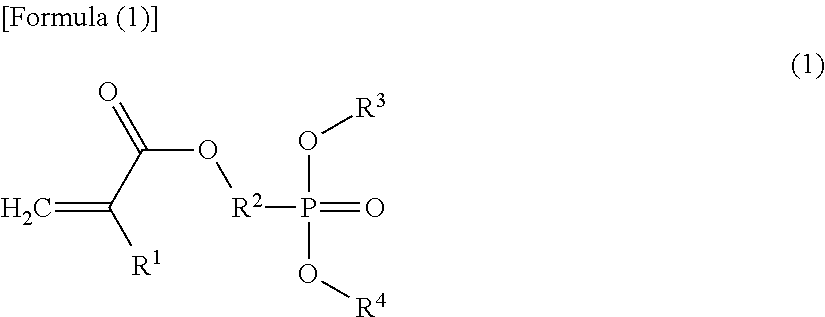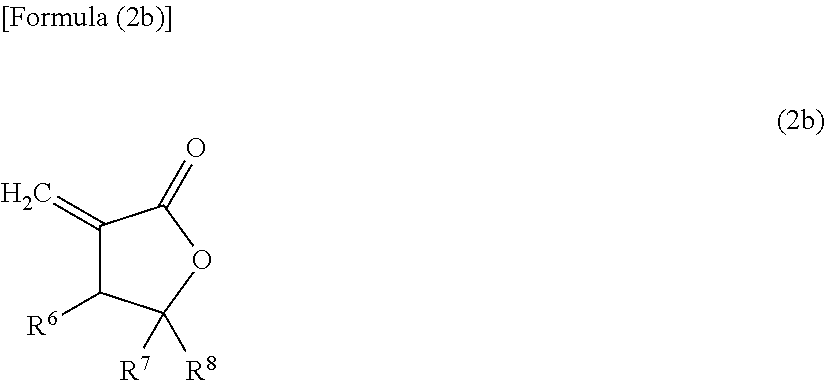Copolymer and molded body
a technology of molded body and polymer, which is applied in the field of polymer and molded body, can solve the problems that the above resin composition may not be suitable for use in a material which requires high transparency, surface whitening, and reduced fire retardancy, and achieves excellent transparency and fire retardancy, suppress heat transfer, and high glass transition temperature
- Summary
- Abstract
- Description
- Claims
- Application Information
AI Technical Summary
Benefits of technology
Problems solved by technology
Method used
Image
Examples
synthesis example 1
[0116]In 400 ml of methylene chloride, 153.4 g (1.0 mol) of phosphoryl chloride was dissolved to obtain a solution. To this solution, a mixture of 142 g (0.99 mol) of 2-hydroxypropyl methacrylate and 100 g (0.99 mol) of triethylamine was added dropwise over 2 hours while stirring under a nitrogen atmosphere at not higher than 10° C. Then, it was heated to 50° C., and stirred for an additional 2 hours. Subsequently, it was cooled to room temperature, and water was then added to quench the reaction. The water layer was removed. The organic layer was washed twice with 200 ml of 0.1 N hydrochloric acid saturated with sodium chloride, and then washed with 200 ml of water until the pH became neutral. The organic layer was dewatered with magnesium sulfate overnight and then percolated. The colature was dried under a reduced pressure to obtain MMEPA.
example 1
[0117]A monomer mixture was obtained by mixing 30 parts by mass of DEMMPO (20 mol % relative to the monomer mixture), 30 parts by mass of TCDMA, 38 parts by mass of MMA and 2 parts by mass of MA. To this monomer mixture, 0.1 part by mass of a polymerization initiator (2,2′-azobis(2-methylpropionitrile), hydrogen abstraction capability: 1%, 1 hour half-life temperature: 83° C.) and 0.1 part by mass of a chain transfer agent (n-octylmercaptan) were added and dissolved to obtain a raw material liquid.
[0118]A mixed liquid was obtained by mixing 100 parts by mass of ion exchange water, 0.03 part by mass of sodium sulfate and 0.46 part by mass of a suspension dispersing agent (B). Into a pressure resistant polymerization vessel, introduced were 420 parts by mass of the above mixed liquid and 210 parts by mass of the above raw material liquid. Temperature was then brought up to 70° C. while stirring under a nitrogen atmosphere to initiate a polymerization reaction. Temperature was increase...
example 7
[0125]A monomer mixture was obtained by mixing 30 parts by mass of DEMMPO, 15 parts by mass of TCDMA, 6 parts by mass of methacrylic acid (hereinafter, may be abbreviated as MAA), 47 parts by mass of MMA and 2 parts by mass of MA. To this monomer mixture, 0.1 part by mass of a polymerization initiator (2,2′-azobis(2-methylpropionitrile), hydrogen abstraction capability: 1%, 1 hour half-life temperature: 83° C.) was added and dissolved to obtain a raw material liquid.
[0126]The above raw material liquid was injected into a glass cell comprising two water-repellent glass plates (10 mm in thickness, 30 cm×30 cm) and a gasket made of a vinyl chloride resin, and was degassed at 760 mmHg for 3 minutes. This glass cell was held at 70° C. for 2 hours, and then at 120° C. for 2 hours to polymerize the monomer mixture. Subsequently, the glass plates were removed to obtain a sheet-like formed article with a thickness of 3.2 mm. A test piece with a length of 127 mm×a width of 13 mm×a thickness o...
PUM
| Property | Measurement | Unit |
|---|---|---|
| glass transition temperature | aaaaa | aaaaa |
| thermal resistance | aaaaa | aaaaa |
| thermal resistance | aaaaa | aaaaa |
Abstract
Description
Claims
Application Information
 Login to View More
Login to View More - Generate Ideas
- Intellectual Property
- Life Sciences
- Materials
- Tech Scout
- Unparalleled Data Quality
- Higher Quality Content
- 60% Fewer Hallucinations
Browse by: Latest US Patents, China's latest patents, Technical Efficacy Thesaurus, Application Domain, Technology Topic, Popular Technical Reports.
© 2025 PatSnap. All rights reserved.Legal|Privacy policy|Modern Slavery Act Transparency Statement|Sitemap|About US| Contact US: help@patsnap.com



